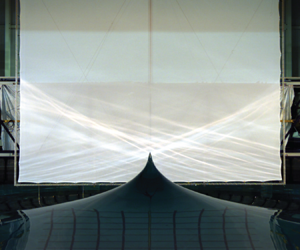Article contents
Wave breaking and jet formation on axisymmetric surface gravity waves
Published online by Cambridge University Press: 25 January 2022
Abstract

Axisymmetric standing waves occur across a wide range of free surface flows. When these waves reach a critical height (steepness), wave breaking and jet formation occur. For travelling surface gravity waves, wave breaking is generally considered to limit wave height and reversible wave motion. In the ocean, the behaviour of directionally spread waves lies between the limits of purely travelling (two dimensions) and axisymmetric (three dimensions). Hence, understanding wave breaking and jet formation on axisymmetric surface gravity waves is an important step in understanding extreme and breaking waves in the ocean. We examine an example of axisymmetric wave breaking and jet formation colloquially known as the ‘spike wave’, created in the FloWave circular wave tank at the University of Edinburgh, UK. We generate this spike wave with maximum crest amplitudes of 0.15–6.0 m (0.024–0.98 when made non-dimensional by characteristic radius), with wave breaking occurring for crest amplitudes greater than 1.0 m (0.16 non-dimensionalised). Unlike two-dimensional travelling waves, wave breaking does not limit maximum crest amplitude, and our measurements approximately follow the jet height scaling proposed by Ghabache et al. (J. Fluid Mech., vol. 761, 2014, pp. 206–219) for cavity collapse. The spike wave is predominantly created by linear dispersive focusing. A trough forms, then collapses producing a jet, which is sensitive to the trough's shape. The evolution of the jets that form in our experiments is predicted well by the hyperbolic jet model proposed by Longuet–Higgins (J. Fluid Mech., vol. 127, 1983, pp. 103–121), previously applied to jets forming on bubbles.
Information
- Type
- JFM Papers
- Information
- Copyright
- © The Author(s), 2022. Published by Cambridge University Press
References
REFERENCES
- 10
- Cited by


